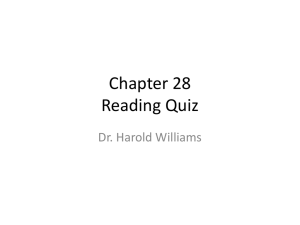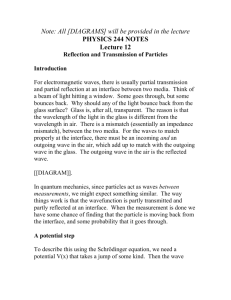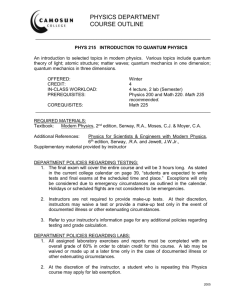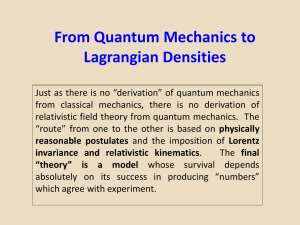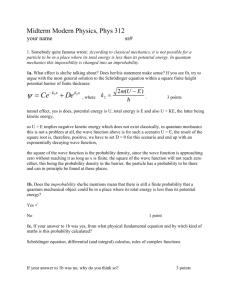A paradox in quantum measurement theory - PhilSci
advertisement
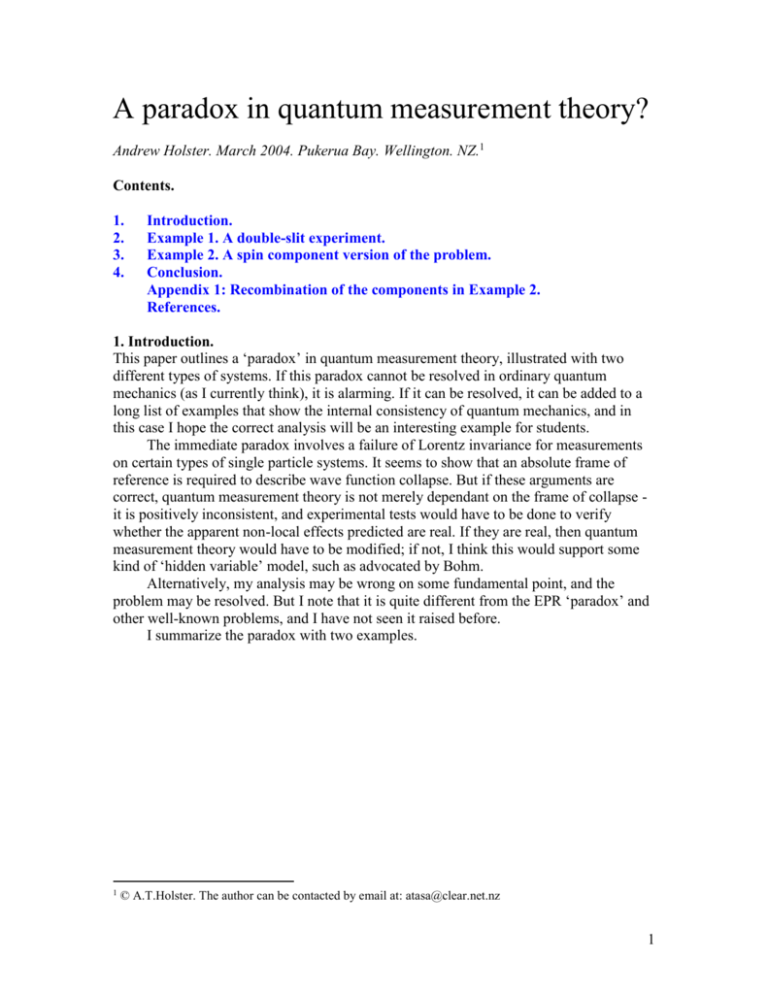
A paradox in quantum measurement theory? Andrew Holster. March 2004. Pukerua Bay. Wellington. NZ.1 Contents. 1. 2. 3. 4. Introduction. Example 1. A double-slit experiment. Example 2. A spin component version of the problem. Conclusion. Appendix 1: Recombination of the components in Example 2. References. 1. Introduction. This paper outlines a ‘paradox’ in quantum measurement theory, illustrated with two different types of systems. If this paradox cannot be resolved in ordinary quantum mechanics (as I currently think), it is alarming. If it can be resolved, it can be added to a long list of examples that show the internal consistency of quantum mechanics, and in this case I hope the correct analysis will be an interesting example for students. The immediate paradox involves a failure of Lorentz invariance for measurements on certain types of single particle systems. It seems to show that an absolute frame of reference is required to describe wave function collapse. But if these arguments are correct, quantum measurement theory is not merely dependant on the frame of collapse it is positively inconsistent, and experimental tests would have to be done to verify whether the apparent non-local effects predicted are real. If they are real, then quantum measurement theory would have to be modified; if not, I think this would support some kind of ‘hidden variable’ model, such as advocated by Bohm. Alternatively, my analysis may be wrong on some fundamental point, and the problem may be resolved. But I note that it is quite different from the EPR ‘paradox’ and other well-known problems, and I have not seen it raised before. I summarize the paradox with two examples. 1 © A.T.Holster. The author can be contacted by email at: atasa@clear.net.nz 1 2. Example 1. A double-slit experiment. Average interference node at B. Incoming wave Detection screen B B1 Hole 1 1 Detection screen A is removable. A1 A2 B2 2 Alternative Acomponent Detection screens: A2 Hole 2 Blocking filters separate components reaching screens A or B. A1 Final blocking screens. Constructive interference node at A. rz rx ry ry=0 at detection screens Figure 1. Components in a special double-slit interference experiment. Components may be distinguished by whether they originate from Holes 1 or 2, or whether they arrive at detection screens at A or B. Additional diffraction effects from the blocking filters are not illustrated, but these filters can be dispensed with, although they enhance the effect. The problem in Example 1. Four components of an incoming particle wave (e.g. a photon) from the left are assumed to survive to reach the detection screens on the right. These components are in superposition. We assume the position of the measuring screen B at the top of the diagram is chosen so that the superposition effects cancel there, i.e. the intensity is just the average intensity we would obtain just from the mixture of components. In the region A at the bottom of the diagram, we have a choice of the measurement we make. We can detect at screen A, which is placed at a constructive superposition node – giving a detection rate greater than that from the mixture of components from the two holes separately. In this case, if we detect the particle at A, we cannot tell which hole the particle originated from (knowledge of momentum is destroyed). Alternatively, we can remove A, and detect at screens (A1 and A2). In this case, the superposition effect expected at A disappears; we can now tell which hole the particle originated from (a momentum measurement); and the intensity is the same as from the mixture of components from the two holes. 2 Hence, the detection rate at A can be altered, depending on this choice. But if the detection rate at A alters depending on this choice, then it seems that the rate of detection at B must also change, because the total detection rate must be constant. The problem is that we can separate the screens A and B to an arbitrary distance, so the respective measurement events are space-like separated, and then the choice of measuring A or measuring (A1 and A2) would alter the rate of detection at B in a nonlocal way. But if this was so, then we seem to require an absolute time frame to tell whether the measurement at A or B was made first. For if we assume that (i) the total overall rate of detection at A and B is constant, then (ii) if the detection at B is made first (in an absolute time frame), it must have a constant rate independent of what is measured at A, and so (iii) the subsequent detection at A must also be constant, whether we detect on A or on (A1 and A2); and this seems to require that the interference effect expected at A must disappear – so we can tell that B is detected first! Alternatively, if the measurement in region A is made first, then the detection rate at B alters depending on whether we choose to detect at A or at (A1 and A2); hence the detection rate at B alters by this choice; and we can tell that the measurement at A is made first in an absolute sense. This seems to indicate a non-local causal effect in ordinary QM measurement theory, which would be disturbing enough – but it fact, it makes quantum measurement theory positively inconsistent, because it leads to failure of normalization. This is evident in a second version given next, where components are produced by splitting a particlewave by spin components, which are subsequently recombined. 3. Example 2. A spin component version of the problem. Initial particle prepared in spin zup state; with arbitrary initial phase of 1. (z) = ((x)-(x))/√2 T1 Final particle reconstructed in spin z-up state. (x)/√2 T2 T3 -(x)/√2 Separation on x-spin Separation on z-spin (z)/2 T4 (z)/2 T5 T6 (z)/2 T7 -(z)/2 (z) T8 T9 (z)/2-(z)/2=0 A = 100% B = 0% Detection at A or B. Recombination of pairs of z-spin components, in phase. Figure 2a. If superposition and interference occurs as depicted, then the (idealized) detection rate at A is expected to go to 1. 3 (z) Initial particle prepared in spin z-up state; with arbitrary initial phase of 1. … or detection at A (z)/2 (z) = ((x)-(x))/√2 (x)/√2 (z)/2 (z)/2 -(x)/√2 -(z)/2 A = 50% Recombination of z-components, in phase. d B1 = 25% B2 = 25% Separation on x-spin Separation on z-spin Detection at B1 or B2… Figure 2b. Same as in Fig. 2a, except components T5 and T7 are no longer recombined in phase at B¸ but detected separately. In this case, the (idealized) detection rate at A is expected to go to 0.5. The problem in Example 2. In this experiment, we take a spin-1/2 particle in the pure z-up spin state (z), and use Stern-Gerlach magnets to split it into four component waves. We then recombine them in spin-state pairs, using pairs from opposite branches of the network with the same spin-z states. In this case, we have a choice of how to recombine and measure at B. Fig. 2a shows superposition of the pairs in phase, and we appear to get a cancellation of the wave in the lower branch, and a positive superposition in the upper branch – in fact, we have reconstructed our original (z)-spin wave. In this case, the particle should always found at A. Alternatively, in Fig. 2b, we detect the two components at B separately; in this case, we should detect these at the rate of 0.25 each, and we can only detect A at the rate of 0.5. Spin-state superpositions. We assume that phase relations in recombination processes can be controlled; this is considered subsequently. Let the state at initial time t0 be (t0), given by the product of a spatial state, u1 , and spin state, z (spin-up on z)2: (t0) = (u1z) u1 represents a coherent particle wave traveling towards the first S-G apparatus in the +ydirection, on a center-of mass y-axis (labeled as component T1). We assume all basis 2 See Merzbacher 1970, Ch.12, or any general text for details. Bohm 1950 has good explanations. 4 states, u1 z , etc, are normalized to 1. We choose the initial phase of the wave as 1 for convenience. By definition, the z-spin basis system: (zz) is linearly related to the alternative systems: (xx) and (yy) by: (2) z = (xx)/√2; x = (zz)/√2; y = (ziz)/√2; z = (xx)/√2; x = (-zz)/√2; y = (ziz)/√2; So we can write the first state as: (3) (t0) = (u1z) = u1(xx)/√2 = u1x/√2 - u1x/√2 When this is sent through the first S-G magnet, the magnetic field separates exactly these two spin-x components into distinct spatial trajectories: u2 and u3. (4) (t1) = u2x/√2 – u3x/√2 We can express these in the spin-z basis, as: (5) (t1) = (u2z/2 + u2z/2) + (u3z/2 – u3z/2) When these are sent through the second and third spin-z S-G magnets, these four components are separated into distinct spatial trajectories: u4, u5, u6, u7. (6) (t2) = u4z/2 + u5z/2 + u6z/2 - u7z/2 We now spatially recombine the pairs of component waves with the same spin, into two more distinct spatial trajectories: u8,u9: (7) (t3) = u8z/2 + u9z/2 + u8z/2 – u9z/2 But this state is just: (8) (t3) = u8z+ (0)u9z We can also arrange that the regions of channels T8 and T9 (regions A and B) are arbitrarily distant from each other. By Eqs.6 and 8, the probability of finding the particle in the region A changes from: (9) |u4z/2|2 + |u6z/2|2 = ¼ + ¼ = ½ before the recombination processes, to: (10) |u8z|2 = 1 5 after both recombinations. The probability of finding the particle in the T5-T7T9 channel likewise changes from ½ to 0. The particle has ‘transferred’ from the region of T8 to region T9, in the period taken to perform the recombination-and-detection process. This can be made arbitrarily small in comparison to the distance between region T8 and T9. Figure 2b shows the distance, d, between regions A and B exaggerated, and shows how probabilities would be expected to change if experimenter at B instead measured the particle without allowing recombination, and before recombination by A. Note that the normalization of probabilities is also disrupted at A, because: |u8z|2 = 1 ≠ prob(A) = 0.5. See Appendix 1 for more details of the possibility of recombination of components. 4. Conclusion. These effects should not be possible in quantum mechanics. They indicate that an absolute frame of reference would be required to interpret the measurement process. If real, they would represent a real non-local causation, not merely the usual non-local correlations found in quantum mechanics. In fact, such effects would make ordinary quantum measurement theory inconsistent. But it would be premature to speculate on the implications of this without independent confirmation that my analysis of these experiments is correct. However, I will note what seems to me an oversight in the usual proofs against non-local causation or signaling in the current literature, which claim to show that nonlocal causal effects are impossible in quantum mechanics. The proofs I am aware of apply to multi-particle systems, typically singlet state pairs, and show that measurements on one particle cannot be used to directly signal to another. (E.g. see Ghirardi, et alia, 1980; Redhead, 1990). But these proofs already assume, as a kind of induction basis, that there is no problem with single particle systems to begin with. I.e. we (i) assume a class of (single particle) systems that cannot display non-local causal effects, and: (ii) show that no measurements on the combination of two or more such systems can generate nonlocal causation or signaling either. But it is the initial assumption, (i), that is questioned here; it concerns partial, space-like separated measurements; and as far as I know, there is no proof of this: it is taken as an assumption. I look forward to discovering an error in my analysis of these experiments. I will consider and dismiss one possible objection to Example 2 in Appendix 1. A full analysis of Example 1 is beyond the scope of this paper. Appendix 1: Recombination of the components in Example 2. It is vital to consider the recombination in Example 2 in detail, and a problem arises if we consider the time reversals of the experiments. The reversal of Experiment 5 is most definitely impossible, because it would involve two component wave functions ‘appearing’ out of an empty space. The recombination of two orthogonal spin components (e.g. T2 and T3) is quite straightforward (theoretically), because we can: (i) reverse the z-velocities of the two outgoing components using a smooth and continuous EM interaction, and bring the two component waves back together physically with the reversed z-velocities as they separated, and (ii) place a spatially-reflected copy of the first 6 S-G magnet at their recombination point, so they go though exactly the reversal of the separation process, and emerge recombined. B- field: By S-G Magnet S-G Magnet B- field: -By Figure 3. Recombination of two orthogonal spin components is possible. However, the perfect recombination of parallel spin components (such as T4 and T6, or T5 and T7) is not strictly possible, because there is no way of creating a potential to recombine two components having different velocities, if they otherwise have exactly the same properties as each other. For suppose we bring two component beams back together; they will have to act differently to each other in the region where they finally recombine, so that their different y-velocities can be adjusted to the same value. But if the beams have identical charges and intrinsic momenta and magnetic moments, then there is no possible potential to differentially act on them. If there was such a potential, then it must refer to ‘orthogonal’ properties of the two component waves; and this automatically reduces interference between the waves to that of a mixture (of the two orthogonal properties, as in the orthogonal spin components). Incoming component, spin-up z Incoming component, spin-up y x Potential in this region would have to act differently on the two components - since is accelerated toward -z, but is accelerated toward +z. Figure 4. Perfect recombination of two parallel spin components is not possible. 7 Hence the idealized experiment in which the two spin-up (or two spin-down) beams are brought back precisely into line is impossible in principle. This can be seen by imagining the dynamic reversal of the experiment. In this case, a beam is sent backwards through the device, and splits it into two components; to do this, the device must set up a potential which acts differentially on the two split components; but by hypothesis, there are no properties which differentiate the components. Hence the idealized setup is impossible. However this does not automatically solve the problem: it shows that a perfect recombination is not possible, but an approximate recombination is enough to cause the paradox. Approximate combinations are all that can be achieved in practical experiments that demonstrate interference anyway, so that is not a problem in itself. To see this, consider that we can at least cross the beams at a narrow angle, and get an approximately linear intersection: y1 Location measurement, A Alternative location measurement, B y2 Same phase, c1 = c2. Common beam width = w. Common wavelength: y y=y1= y2 Figure 5. Approximate recombination of two parallel spin components. The phase difference y/y across the location measurement A is approximately, for a small angle : y/y = 2w tan(/2)/y ≈ w sin()/y If y<<y, then phase across the surface of A is very nearly constant for both beams, and if they are crossed in phase, interference is almost completely constructive right across A. Because the two components are in phase, this constructive interference applies throughout the shaded interference region. And whatever the phase relations, interference will occur across A, with a similar interference effect at each point. 8 This allows the paradox: the component waves interfere constructively in the A region at time t4, giving for a small volume dr3 around a point r in A: |c(r,t4)|2 dr3 = |c1(r,t4)+ c2(r,t4))|2 dr3 This is not equal to the corresponding size a short time later at t5, when the wave components in the volume dr3 have separated and ceased to interfere, and give approximately: Ut5(|c(r,t4)|2 dr3) = |c1(r,t4)|2 dr3 + |c2(r,t4))|2 dr3 where Ut5 is a time transformation, based on the unitary transformation of the wave components in dr3 from t4 to t4. The two differ by the interference terms: c1(r,t4)*c2(r,t4))+ c2(r,t4)*c1(r,t4) Uncertainty Relations. The problem is therefore whether y can be made very small. y can be made very small if we can sufficiently reduce the size of the angle for a given and w. I will now consider an argument that there are uncertainty relations prohibiting this, which I will then dismiss. For each component wave, we can assume an uncertainty relation between position and linear momentum, in both the y and z directions separately; say roughly; ypy = ћ, and zpz = ћ. Also roughly: z= w. We also need the beam to be ‘stable’ in the z-coordinate over the passage of time for the experiment, so we need the average momentum in the y-direction <py> to be considerably larger than the variation in zmomentum, pz. I.e. <py> >> pz. And we relate: <y> = ћ/<py>. It follows that: ћ/<y> >> ћ/w, or: w >> <y>. Let us say that: w = Ny, for some large N. Then the earlier relation gives: y ≈ w sin/y = Ny sin/y = N sin. Hence, to obtain: y<1/4, as we roughly need for an identifiable effect, we need: sin(≈ <1/4N. So has to be very small. But by definition: = pz/<py> = N > . Hence, the uncertainty in the direction seems to prevent the recombination from occurring in a way that is precise enough to give consistently constructive interference. But this argument is invalid. First, the notion of the uncertainty of has been used ambiguously. First it is defined by: = pz/<py>. This is a property of the ‘spread’ of any individual wave function with time. But then it is treated as if it means the standard deviation of the center of mass angle, of the wave function. If we cannot control the 9 latter precisely enough, we are in trouble; but its variance has nothing to do with the former concept, . Suppose we used an apparatus that prepared the desired center of mass wave functions almost perfectly for an ensemble of particles, so that the mean angle of the particle beams is: <>= and there is only a very tiny variance of this mean: (<>), about . Each particle nevertheless has the quite independent uncertainty pz/<py> in This not as a result of uncertainty about what the wave-function center of mass angle is, i.e. (<>); it is merely uncertainty about what a measurement of the z-location of the wave function would find the collapse trajectory angle to be (the average spread of the wave function). The argument would only work if there was some further direct relation between and (<>), but there isn’t. (<>) depends physically upon the precision of the apparatus, whereas is an intrinsic property of the wave function. While we cannot control the parallel-spin waves accurately enough to make their center of mass trajectories overlap exactly, there seems every reason to think that the angles and lengths can be adjusted precisely enough to generate significant interference effects. This problem does not arise in the first experiment. References. Bohm, David. 1951. Quantum Theory. Prentice-Hall Inc. Ghirardi, G.C., A. Rimini and T. Weber. 1980. "A General Argument against Superluminal Transmission through the Quantum Mechanical Measurement Process". Lettere Al Nuovo Cimento 27 (10) pp. 293-298. Merzbacher, Eugene. 1970. Quantum Mechanics. John Wiley and Sons. New York. Redhead, Michael. 1990. Incompleteness, Nonlocality, and Realism. Oxford. 10

